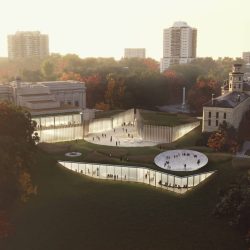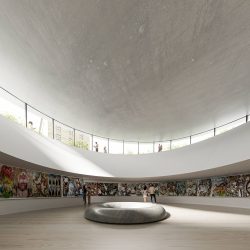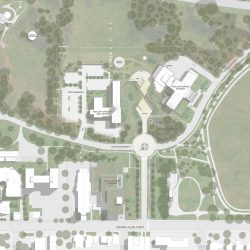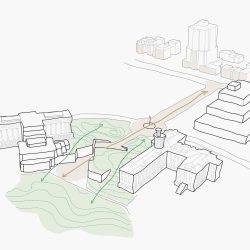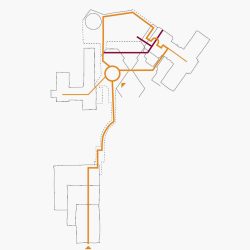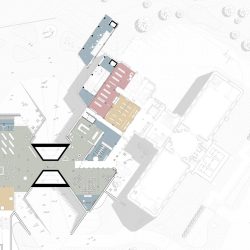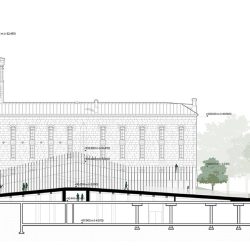
As architects, when we build, we often take space from the city. With our proposal for the future extension of Musée National des Beaux-Arts du Québec (MNBAQ), we aim to give space back to the city. Our proposal for Espace Riopelle is conceived equally as a landscape and as a building, intended to reconnect Québec City to the Plains of Abraham, above, below and through the MNBAQ.
The existing pavilions of the MNBAQ feature such rich architectural qualities that a subtle, balanced, and sensitive solution is needed for the future Espace Riopelle. Rather than adding a new volume in this already complex environment, we have consciously decided to remove building form, to lighten it and to release views to the surrounding landscape and to the existing pavilions. Inspired by Riopelle, we have chosen to work as he did – through contrast, through negative imprint, and through absence.
Our proposal for the new Espace Riopelle is both modest and audacious, present with its visible absence. The new addition does not bare itself to ones eyes in a blatant way, yet it has an utterly powerful presence – the visitor experiences it, lives it, feels it.
The MNBAQ campus is comprised of an ensemble of pavilions from different time periods over the past 150 years. It includes the Charles-Ballairgé pavilion from 1867, the Gérard-Morisset pavilion from 1933, the Central pavilion from 1991, and the recent Pierre-Lassonde pavilion from 2016. Home ground to significant historic battles, the Plains of Abraham is to Québec City what Central Park is to New York: a city park of outstanding value, the green lungs of the city.
Our proposal is conceived of as both a landscape and a building. It aims at reconnecting the city to the park: above, below, and through the MNBAQ, making the museum, the site, and the park more porous, open and accessible. This new outdoor space becomes a generous public plaza drawing visitors inward with its land art-like design.
To mark the presence of the new Espace Riopelle, a unifying, sculptural approach has been used on all ground floor facades. These facades are transparent and covered with vertical profiles – cast aluminum lamellas – that dress the facade in a coherent expression. From afar, the vertical elements form a sculptural triangular element – a new powerful signal for the MNBAQ, the vision of a living and inclusive museum.
Passing through this new public space, visitors are set on a journey of discovery. The lamellas, which seem closed upon approach, open up and form a progressive and unexpected discovery of the museum, one where landscape transitions into architecture. Step by step, the perception not only of this space, but of the entire museum changes. It draws the visitor in to a new relationship with nature, built form, space, light and time. It celebrates the logic of the place in its simplicity.
Through the subtle incline of the public space, the interior continuity of the Central pavilion is maintained. This ensures the full integration of the museum circuit below, which connects flows between the new Carrefour Riopelle, the hall and the Morisset pavilion.
Towards the park, the new exhibition halls have been placed in the landscape to create an immersive Riopelle experience in his most cherished of all elements, nature. By doing so, the legibility of the existing pavilions are respected and preserved. The new exhibition halls reveal themselves through a cut in the landscape, drawing the museum visitor closer to nature and to the Plains of Abraham.
The exhibition halls have been designed to accommodate the wide variety of Riopelle’s works. Three types of exhibition halls are imagined, differing in their temporality but also in their content. Each hall has a structural system that responds to its contents.
For the design of the space dedicated to Riopelle’s most iconic painting, the 40 m long Hommage à Rosa Luxembourg, the starting point is the artwork itself. The exhibition space is arranged in a circle where the two ends are slightly offset like a spiral, in order to offer a fluid entry into the space, a progressive discovery of the artwork and an uninterrupted reading of the painting.
This exhibition space is more than a mere container. It is not limited to the interior of the museum, but reveals itself on the outside, as its roof emerges from the ground into the Kiosque Riopelle. Placed in the landscape of the Plains of Abraham, the Kiosque Riopelle becomes a place of generosity, exchange, and events for the MNBAQ, the Plains of Abraham and the City of Québec.
_


